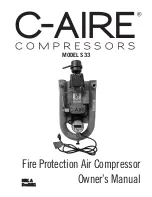
23
AB243586442172en-001401
Operating conditions
The scroll compressor application range is
influenced by several parameters which need to
be monitored for a safe and reliable operation.
These parameters and the main
recommendations for good practice and safety
devices are explained hereunder.
•
Refrigerant and lubricants
•
Motor supply
•
Compressor ambient temperature
•
Application envelope
(evaporating
temperature, condensing temperature, return
gas temperature)
General information
Refrigerant and lubricants
When choosing a refrigerant, different aspects
must be taken into consideration:
• Legislation (now and in the future)
• Safety
• Application envelope in relation to expected
running conditions
• Compressor capacity and efficiency
• Compressor manufacturer recommendations
and Guidelines
Additional points could influence the final choice:
• Environmental considerations
• Standardisation of refrigerants and lubricants
• Refrigerant cost
• Refrigerant availability
SH compressors are to be used with R410A
refrigerant, with polyolester oil.
• R410A’s superior thermodynamical properties
compared to R22 and R407C refrigerants allow
for today’s massive – and necessary – switch to
high efficiency systems.
• Zero Ozone Depletion Potential (ODP): R410A
does not harm the ozone layer.
• Global warming potential (GWP): R410A shows
a relatively high warming potential. However,
the GWP index denotes direct warming effect,
which is relevant only in case of release to the
atmosphere. A more accurate index is T.E.W.I.,
for Total Equivalent Warming Impact, which
takes into account indirect contributions due to
running energy costs.
• Because of the higher system efficiency it allows
to achieve, R410A is in this regard the best
refrigerant.
• As a near-azeotropic mixture, refrigerant R410A
behaves like an homogeneous substance,
whereas other zeotropic mixtures such as
R407C and other blends suffer a temperature
glide during phase change that lessens thermal
efficiency and makes them difficult to transfer
from a container to another.
• Reduced refrigerant mass flow, permitted by a
higher heat capacity, induce a lower sound level
of the installation as well as more compact and
lighter systems.
Danfoss Commercial Compressors, along with
the whole refrigeration and air conditioning
industry, shares today’s concern about the
environmental issues that are ozone depletion,
global warming and overall energy consumption.
Usual HCFCs refrigerant fluids such as R22
are known to be implicated in these harmful
phenomena, especially ozone depletion due to
their chlorinated content. These substances are
scheduled to be phased-out from production
and use in coming years, in accordance with the
international Montreal Protocol (1984).
As a result, new chlorine-free molecules have
been recently developed and are now ready to
replace former fluids. Among those refrigerants,
the HFC blend R410A is admitted by a great
majority of manufacturers to be the most
promising in terms of environmental impact,
stability and efficiency, and is already seen as the
R22 replacement.
R410A
Refrigerant
R22
R407C
R410A
Chemical
properties
Chlorine content
yes
no
no
Zeotropic
pure refrigerant
zeotropic mixture
near azeotropic mixture
Composition
R22
R32/R125/R134a
R32/R125
Environmental
impact
ODP
0.05
0
0
GWP
1500
1526
1725
Thermodynamic
properties
Vapour pressure (bar) at 25°C
10.4
11.9
16.5
Cooling capacity of liquid (kJ/kg.K) at 25°C
1.24
1.54
1.84
Cooling capacity of vapor (kJ/kg.K) at 1 atm, 25 °C
0.657
0.829
0.833
Temperature glide (°C)
0
7.4
<0.2
Application Guidelines
Summary of Contents for SH485
Page 2: ......
















































